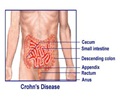
Inflammatory bowel disease (IBD) is the general name for diseases that cause inflammation in the small intestine and colon, which include Crohn's disease and ulcerative colitis. IBD patients are at high risk for developing dysplasia and colorectal cancer. Chromoendoscopy (CE) is used for dysplasia surveillance in IBD patients. It is a special technique used in conjunction with endoscopy to improve visualization of the mucosa or lining of the intestine and can help the endoscopist find abnormalities that are present during the endoscopic examination which may be difficult to identify using only "white light" endoscopy. Chromoendoscopy is performed by spraying specialized nonpermanent stains or dyes on the lining of the intestine during the endoscopic procedure.
Narrow band imaging (NBI) with endoscopy offers the potential for improved visualization and was developed to enhance certain mucosal or vascular characteristics so that abnormal growths are visualized better. It uses a special filter to illuminate tissue in the lining of the intestines with light at specific wavelengths, which enhances underlying vasculature and produces the greatest contrast between the vessels and surrounding mucosa. This can help the endoscopist see the margins of an abnormal growth better and assist in determining which areas are the best to biopsy.
"In recent years, several studies have shown that chromoendoscopy is more accurate in detecting dysplasia in patients with long-standing inflammatory bowel disease than conventional endoscopy," said study lead author Maria Pellisé, MD, Gastroenterology Department, Institut de Malalties Digestives I Metabòliques, CIBERehd Hospital Clinic, Barcelona, Spain. "The aim of this study was to compare new-generation NBI systems with high-resolution imaging with CE for the early detection of colitis-associated dysplasia and cancer in patients with long-standing colonic IBD. We found that NBI is a useful technique for the detection of dysplasia in patients with long-standing IBD that offers several advantages including efficiency, ease of use, and agility. However, the relatively high rate of missed lesions with NBI prevents its recommendation as the new standard technique of use."
MethodsConsecutive patients with clinically inactive, long-standing ulcerative colitis involving at least the left colon or patients with colonic Crohn's disease affecting at least one third of the colon were recruited from the Outpatient Clinic of the Gastroenterology Department at Hospital Clinic, Barcelona, Spain. A total of 60 patients were included in the prospective, randomized, crossover study.
Each patient underwent high-resolution NBI colonoscopy and high-resolution indigo carmine CE with an interval of three to eight weeks between procedures. The order in which the examinations were performed was randomized (1:1). All colonoscopies were conducted by one of two experienced endoscopists who were blinded to the endoscopic and histological findings obtained during the first procedure. The morphology, size and location of any visible lesion were recorded. Any suspicious lesions detected during the examinations were sampled or immediately removed after detection. Biopsy samples were processed and stained by using standard methods and were subsequently evaluated by an experienced gastrointestinal pathologist.
Advertisement
The researchers concluded that NBI appears to be a less time-consuming and an equally effective alternative to CE for the detection of neoplasia, but with a higher miss rate, and so NBI cannot be recommended as the standard technique. As a consequence, they believe that CE should still be considered the technique of choice for detecting dysplasia in patients with long-standing IBD.
Advertisement
Source-Eurekalert








